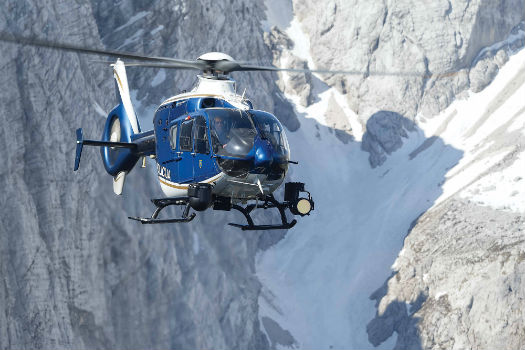
The Slovenian Police Air Support Unit’s Airbus Helicopters EC135 P2+ in Slovenia’s Julian Alps.
In southern central Europe, on the sunny side of the Alps with the Adriatic Sea to the west, and Pannonian lowlands to the east, lies the Republic of Slovenia — home to the small, but extraordinarily versatile Slovenian Police Air Support Unit. The unit is one of only a few in the world that, in addition to police work, provides helicopter emergency medical services (HEMS), mountain rescue, commercial operations, filming and cargo transport services.
The unit was founded in 1967 with the purchase of an Agusta-Bell AB47-J2A, which was nicknamed “Burdush.” In the following years, the unit grew with the acquisition of two Agusta-Bell AB206 JetRangers, an Agusta-Bell AB212 and an Agusta-Bell AB412. Later, as the country joined the European Union, an Agusta A109E Power and Eurocopter EC135 P2+ were added to the fleet for police work. And, as the fleet grew, so did the variety of missions the unit performed.

Among 22 pilots in the unit are two female pilots — Tanja (right) and Breda (left), here in the Agusta-Bell AB212.
Today, there are six helicopters in the fleet, and the unit employs 22 pilots and 15 aircraft maintenance technicians (the latter also serve as crewmembers on many missions). As Slovenia is a small country, both in terms of population (two million) and size (7,800 square miles/ 20,300 square kilometers), the unit is able to cover the whole country from a single base, which is located at Airport Jože Pučnik in Ljubljana, Slovenia’s capital city. The head of the technical part of the unit is Roman Rovanšek (who was previously head of the Slovenia’s aviation accident investigation board), the chief pilot is Damjan Bregar (who has been a pilot in the unit for the past 23 years), and the head of the unit and appointed accountable manager is Uroš Marjetič (a former police Special Unit bomb technician).
A typical day at the air support unit starts at 8 a.m. with a briefing of all the personnel. The briefing leader presents the scheduled tasks for the day and continues with meteorological and aeronautical information. Although Slovenia is a very small country, it has three major climatic influences — Alpine, continental, and sub Mediterranean — which can provide very diverse conditions on any given day.

The unit’s AgustaWestland A109E Power is used for police work and HEMS operations.
The unit’s scheduled daily police tasks are typically border and traffic patrols, as well as air support for the Police Security and Protection Centre, Criminal Police Directorate, Police Mountain Unit and Special Unit.
The HEMS and police intervention crews are standby crews, and will be airborne within 10 minutes of a call. In the high mountaineering season in the summer, the mountain rescue crew is also on standby.
When the sun sets, the night police intervention crew takes over. HEMS and mountain rescues are not conducted during the night.
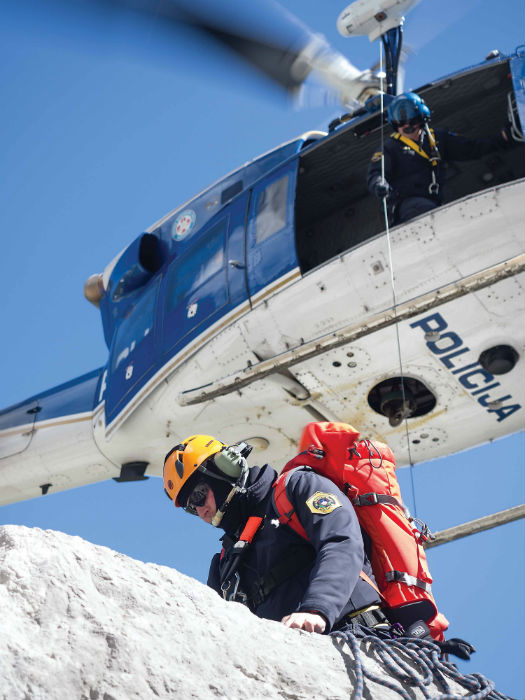
The unit performs mountain rescue training with its Agusta-Bell AB212.
A Fleet for all Missions
The unit’s fleet is versatile to cover the range of police and humanitarian missions it needs to complete.
The two AB206 JetRangers serve as initial training helicopters, and are also used to complete various police tasks — such as border and traffic patrols, searching for missing people, pursuing criminals, and air monitoring of different convoys or police operations.
The AB212 and AB412 are the workhorses of the unit. Often used in cooperation with the Police Mountain Unit and Special Unit, they spend a significant proportion of their flight time performing humanitarian missions, which include HEMS calls and mountain rescues. (The aircraft are also used for firefighting, through the use of Bambi Buckets and external cargo transportation.)
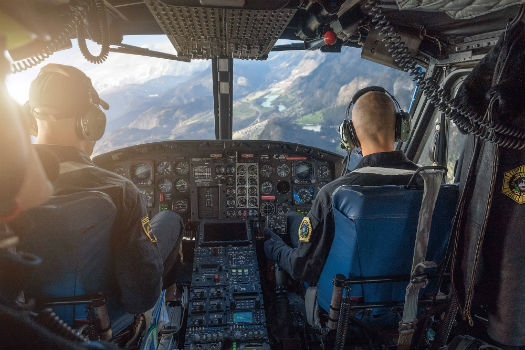
The view from inside the Slovenian Police Air Support Unit’s AB212 as it approaches the Karavanke mountains.
Mountain rescues are conducted in cooperation with the Mountain Rescue Association of Slovenia, and several mountain rescue practices are performed periodically before the high season. As well as allowing the team to hone their techniques, the practices also serve to renew the annual licenses of the mountain rescue personnel.
For HEMS missions, the aircraft also have the capability to transfer neonatal patients in incubators.
The HEMS and mountain rescue crews consist of a pilot, a co-pilot, and a maintenance technician. The medical crewmembers include one doctor and one medical technician. Currently there are 25 medical crewmembers trained for HEMS operations with the unit, and all of them are employees of the Slovenian Ministry of Health. Their training in helicopter operations is performed in the unit. For mountain operations, the Mountain Rescue Association of Slovenia provides a group of doctors and mountain rescuers specialized in helicopter operations, and they train together with the unit’s mountain rescue crews.
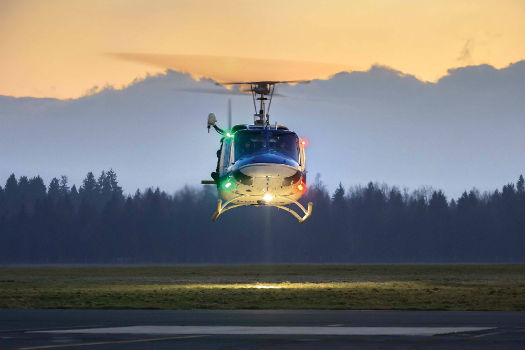
The AB212 departs from the unit’s base at dusk for night flying training.
A particularly memorable mission last year saw the AB212 save the lives of 117 people who were trapped in their homes when severe flooding hit Bosnia and Herzegovina. The unit flew all of them to safety (hoisting some from the rooftops of their houses), as well as transporting water, cargo, and medicine to others in need. In recognition of the team’s effort, the unit received a state decoration from Bosnia and Herzegovina, and a certificate of appreciation from the United Nations.
Currently, the AB412 is undergoing a mission equipment upgrade — work that is being performed within the unit.
The newest members of the fleet are the A109E Power and the EC135 P2+. The A109E Power’s missions include HEMS, border patrols and police interventions. The EC135 joined the fleet to patrol the “Schengen border” (the outside border of the European Union), and is equipped with forward-looking infrared (FLIR) and video cameras, and a powerful searchlight. While that mission is its focus, the aircraft’s specialized equipment makes it an extremely useful tool for the unit’s regular day and night police missions.
Police missions are typically flown in a crew configuration of a pilot, a co-pilot, and a policeman or a detective specialized for each type of mission. The policeman must also be familiar with the local environment where the mission is taking place. Employees of the police involved in helicopter operations receive initial and refresher training at the unit. A technician joins police missions as a camera/FLIR operator when needed, and, in the case of single pilot operation in the AB206, they also serve as the communications operator.

The unit is Part 145 and CAMO approved. Here, aircraft maintenance technicians work on the Agusta-Bell AB412.
A Crew with Wide Talents
For every mission, the crew leader is the most experienced pilot in the crew. He or she is responsible for the whole operation, and delegates tasks to the other crewmembers.
The diversity of the fleet and missions means the unit’s crewmembers are required to be extremely versatile and adaptive. Most of the pilots are holders of three type ratings, starting with AB206, followed by AB212/412, and then either the A109 or EC135. They gain experience flying single pilot in the AB206s on less demanding missions, and then progress to flying as copilots on multi-engine helicopters. The senior pilots in the unit serve as the pilots in command on the most demanding missions.
Nine of the unit’s pilots are flight instructors and type rating instructors in its approved training organization, which provides training for civil licenses and ratings. The senior pilots are ATPL/H (IR) licensed according to the European Aviation Safety Agency, while the junior pilots are in the different stages of acquiring the same standard. Operational training is provided as well as civil licensing, covering aerial work and police missions. For recurrent safety training, flight simulator courses are utilized at FlightSafety in the U.S., Airbus Helicopters in Germany, and the AgustaWestland training center in Italy.

Half of the unit’s fleet on the apron of its base at Airport Jože Pučnik in Ljubljana.
“The most challenging part of the unit’s work is the versatility,” said Damjan Bregar, the unit’s chief pilot. “Combining humanitarian work and police work; scheduling of the crews according to their type ratings, [the] experience of pilots, duty times, and rest periods; and maintenance [planning] is part of our daily work life.”
Aircraft maintenance technicians have a dual role in the unit — not only are they licensed to perform maintenance, but, in most of the crews, they are also a crewmember. In this capacity, they offer support in start-up procedures, departing and landing procedures, and during the embarking and disembarking of passengers and patients. On mountain rescue and police missions, the technicians are also the winch operators, and FLIR operators, respectively. All pilots and technicians are trained in the use of night vision goggles.
On the maintenance side, the unit is Part 145 and Continuing Airworthiness Management Organization (CAMO) approved, and has the capability to cover line and base maintenance up to the overhaul level for all the types in its fleet.
Although flying three different types of helicopters and performing many different missions is very demanding, the unit’s crewmembers are highly motivated for their work and say they love doing it.
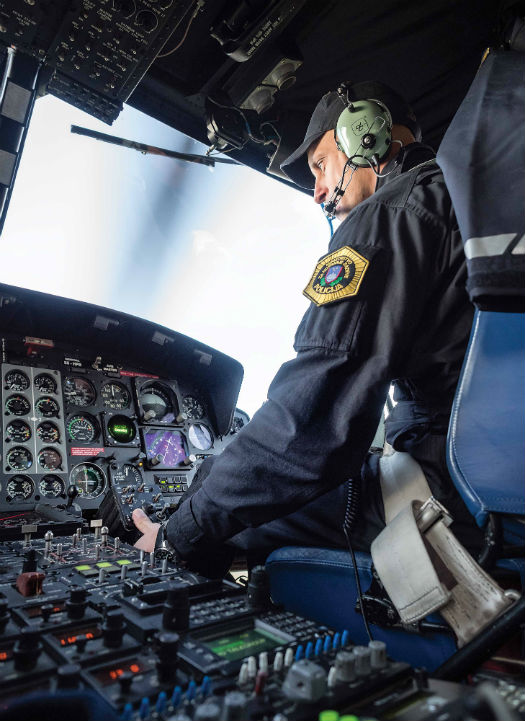
Pilot Miha Pavli flies the AB212. Pavli is also type rated on the Agusta-Bell AB206 and Airbus Helicopters H135.
“The challenge of our work is that it must be always done on-time and without mistakes — that goes both for the aircraft maintenance and the flying part of the job,” said Miha Meško, who is a senior technician and operational training instructor, and has been with the unit for 20 years. “When we are on the mission, safety is our priority. One must always be aware of his own limits and the limits of the whole crew so that the border of safety is never crossed. I always keep in mind that my performance is influencing other people’s lives. Helping people and love for aviation is what motivates me. I am happy that I can do both aircraft maintenance and flying work at my job in the unit — that way my workdays are rich and diverse.”
While the Slovenian Police Air Support Unit may be small, the versatility of its crew and fleet allow it to perform a range of operations that would only usually be seen at a much larger unit — helping those in this picturesque country near the European Union’s southern boundary stay safe and secure.





